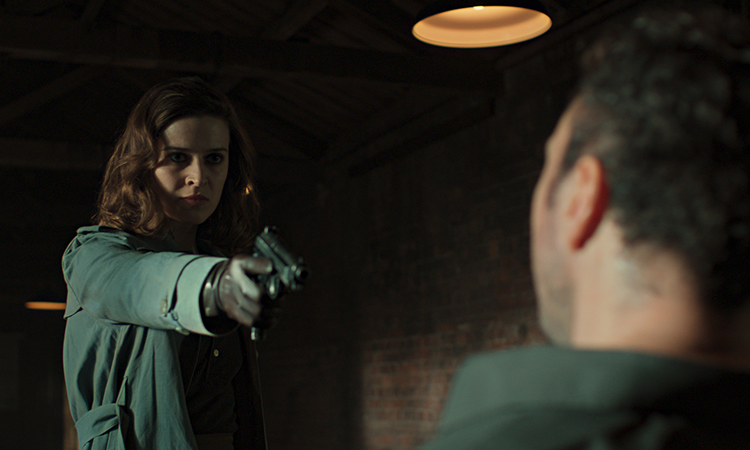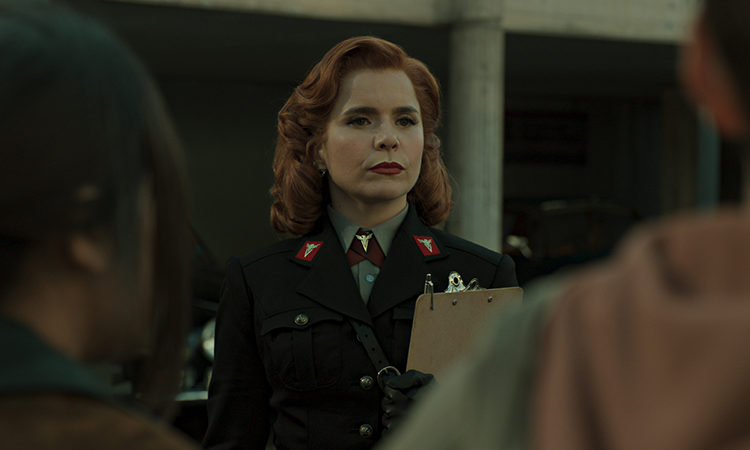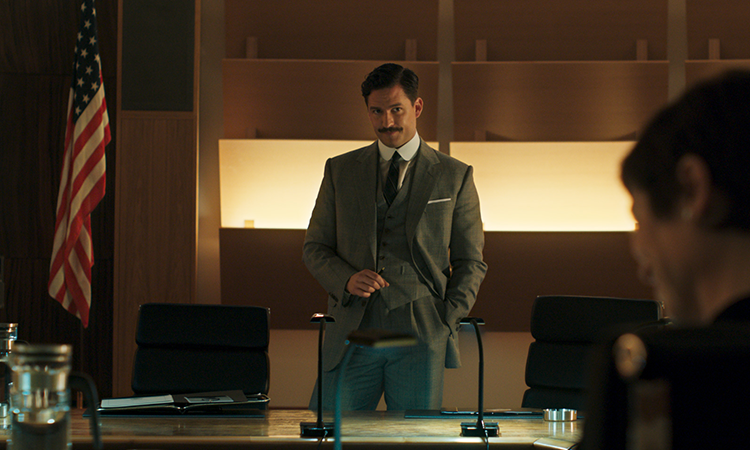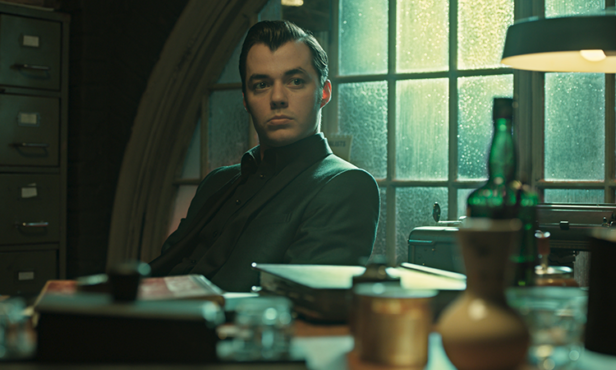“Obviously Michael Caine was a big influence for us,” actor Jack Bannon tells us about the version of Alfred ‘Alfie’ Pennyworth he plays in the DC series, Pennyworth. “He was the one that gave us the SAS background, which we explore, and also he was the archetypal film star of the Sixties.”
Indeed, set during that swinging decade in an alternative London, Pennyworth follows the story of one of the world’s most famous butlers long before he becomes the closest companion of Bruce Wayne and takes up residence in the Bat Cave.
In fact, Season One of Pennyworth (released back in 2019) found Alfie hearing the name ‘Wayne’ for the very first time – in meeting Thomas Wayne (Bruce’s ill-fated father), who’s working as an American spy for the No Name League, a political social faction pitting itself against the nefarious Raven’s Society.
Not that Alfie cares too much about such things; he’s just left a special task force in the SAS and is now busy trying to create his own private security business alongside old SAS buddies Bazza and Dave Boy.
If spies and politics all ring rather James Bond to you then you’re right on the nose on what Pennyworth is all about. After a first series that found Thomas meeting fellow spy and future Mrs Martha Wayne (not that they would know it with their constant bickering); Alfie losing some of the closest people to him, and the UK launching itself into a civil war, it was a thrill ride of an inaugural series and one that people certainly got on board with.
“I think before the first series aired people were kind of ‘oh another Batman spin off’ and didn’t understand that it was very much its own genre and its own thing,” says star Emma Paetz who plays Martha – back for a second series and more badass than ever. “Now that that’s been established, we can play with it a bit more in the second series. For example, this second half of the second series, I think you could argue embraces the comic book form a bit more, and I’m excited to see that now that we’re established, we can kind of like dig into that!”

“Before the first series aired, people were kind of ‘oh another Batman spin off’ and didn’t understand that it was very much its own thing. Now that that’s been established, we can play with it a bit more in the second series.” – Emma Paetz
One element that Pennyworth needed to firmly establish for audiences was the world in which it’s set in. This is a comic book show and though its themes of war and loss are as real as you could possibly get, the world around it is not. Luckily, Pennyworth’s executive producers, Bruno Heller and Danny Cannon, are no strangers to creating a whole new world within the Batman universe – they’re both behind that other Batman origin series, Gotham.
“Me and Danny had been working on Gotham for many years, so we’ve been immersed in the DC mythology,” Bruno tells us. “Alfred’s voice is central to that story, but it’s never really been explored. When you’re looking at that world, you’re always looking to find corners of it that haven’t been explored properly. This was clearly one. Once we started talking about that character it just fell together, because he’s been played wonderfully by Michael Caine. Michael came with this primary model and there was a puzzle there; how does a decorated SAS soldier become a butler of all things? That seems like a great origin story set in a great world, which is London in the early Sixties.”
In this alternative London you’ll find a mixture of the grimy post-depression streets that you’d expect mixed alongside fantastical elements, like huge floating blimps flying in the sky. Bruno describes it “a kind of fantasy London that would exist in a DC universe; an analogy for the way that Gotham is a warped version of New York”.
“I think because it is a DC project, you don’t go off and make a barren minimalist kind of show,” says Danny Cannon, who also directed three episodes of the first series (as well as genre classics I Know What You Did Last Summer and Judge Dredd). “There’s something about the texture of DC comics that were always quite detailed and also quite cluttered. Metropolis was always that, so we wanted London. [We wanted it to] have that same texture, that same design, that same layer upon layer [as DC cities].
“‘Dickensian’ was the word we were using when we were throwing it around,” Danny continues. “Like could Fagan could play a part in Pennyworth? Jack the Ripper, Jekyll and Hyde… those characters would work inside the landscape we were creating.”
“It’s a nostalgic love letter to London and there are certainly things that we find familiar,” Jack adds. “What’s great about this show is there are no rules and we can change it. We can move eras with music or things like that. We had Jimmy Savile in Season One!”
“What’s great about this show is there are no rules and we can change it. We can move eras with music or things like that. We had Jimmy Savile in Season One!”- Jack Bannon
Yes like any good DC story, Pennyworth is littered with an array of characters and not just from Batman lore. You might meet Jimmy Savile, or George Orwell, or one of the notorious members of the Ripper family down a dark alleyway…
“Batman and Joker, [they’re] our folk heroes and folk villains that happen to come from comics,” says Bruno. “The same is true to a degree of characters like Jack the Ripper or Spring Heeled Jack. Even someone like George Orwell. They’re the English equivalent of characters that live in folklore and myth as much as they do in reality. They’re the kind of Dickensian and Penny Dreadful characters of English culture that are very similar in their lineaments to comic book characters.
“Like Joker – he’s right there. You know who he is, he’s instantly recognisable, which is something that comic books have to do. [With] the kind of literature Dickens was writing, the kind of characters that appear [in the show] like Jack the Ripper are similar; they’re right there for you.”
Speaking of Joker, when it comes to the characters from Batman, Pennyworth was also a chance to explore characters who haven’t had much of a voice in the Batman stories we’ve read so far.
“The thing for me certainly was exploring the parents of Batman, Thomas and Martha, especially Martha because what would the mother of someone like Bruce Wayne be like? She must have been quite a character, so those were the inspirations,” says Bruno.
Indeed, the first season shone a light on the blossoming romance between Martha Kane and Thomas Wayne, and though we know the two end up together and have little baby Bruce, the path to wedded bliss is certainly not smooth. In fact, they’re not even a couple when we meet them, which has given both Thomas and Martha the room to become characters in their own right – not just the tragic parents of a hero.
“I really like that Martha doesn’t pander to, or fulfil this archetype of who she is as a mother of Batman,” says Emma. “We meet Martha when she’s not a mother yet. She’s not even in a relationship with Thomas Wayne yet. She’s very much her own person. She’s involved with a revolutionary struggle that she really believes in. She finds a lot of personal value within that cause, so that’s really satisfying to play.”
“We know they end up dead, which is a crap crowning moment, but I think what’s so exciting about what Bruno is doing is how they end up as those,” adds Ben Aldridge who plays Thomas Wayne. “We know that when they die they’re these morally upstanding philanthropic citizens of Gotham. I think what he’s played with so brilliantly is he hasn’t given them a linear journey and they’re not always these good straight forward people. They are both very impassioned and put in very morally compromising situations. I think the journey to that moment is really exciting and quite unpredictable.”
“You’ve got to try and be brave when dealing with characters that are that famous but also that unknown,” adds Bruno. “Yes they are the sort of Joseph and Mary of the Batman religion if you like but they have very rarely been portrayed, especially Martha, and it was one of the things that really attracted me to the project. Martha is the impulsive aggressive vigilante part of Batman’s character and Thomas is more the analytical detective – you put those two together and you have Batman.”
“Martha is the impulsive aggressive vigilante part of Batman’s character and Thomas is more the analytical detective – you put those two together and you have Batman.” – Bruno Heller
Pennyworth not only borrows characters from Batman and British lore, it has also brought us completely original characters, the most outstanding (and outlandish) of which has to be Bet Sykes (yes we spotted the reference in that surname too) – “a kind of fever dream of all the scary English murderesses of the Fifties and Sixties,” as Bruno describes her, played brilliantly by Paloma Faith.
“We initially started off Season One basing Bet Sykes quite heavily on Myra Hindley, both in character and the sort of psychological detachment,” Paloma tells us of the character, who in Season Two looks to have had a makeover: “I think that the American production team got wind of the fact I’ve had another career,” Paloma laughs of her new glamorous look. “They started Googling and they were like ‘Oh, she’s more attractive than that. Let sprinkle a bit of that in. It’s Hollywood after all!’”

“There was a lot of pressure on Paloma to bring Bruno’s character to life because she didn’t have any reference for it,” says Danny. “But it’s funny when you practice how the character stands and how they portray themselves, you end up finding the character quicker than going over all the dialogue. When these characters are first perceived they’re drawn normally in a comic book so you have to create that silhouette, you have to make that silhouette work and then somehow it all comes together. Paloma always talked about that, she always talked about once she found her stance and her walk it was a lot easier to do the rest of it.”
Sykes is part of the Raven’s Society, a group conspiring to take over the British government lead by Lord James Harwood (Jason Flemyng). Season One saw Alfie, Thomas and Martha trying to squash the uprising. However, not quite everything went to plan and for Season Two, they all find themselves in a very real – very dangerous – situation: civil war!
“We are exactly a year later. So Season One ended on the brink of civil war and in Season Two, we are firmly in that civil war,” Ben explains. “We first meet Thomas back in America and he’s promoted to CIA Station Chief, which is kind of a poison chalice. He loves the power, is seduced by that, but he’s kind of unfortunately forced to carry out the decision-making process which aligns the CIA with the Ravens.”
The aftereffects of Season One are still rippling through the second season – Alfie had to make a very dark, very tough choice at the end of Season One and he’s still greatly affected by it: “The events of Season One have taken their toll, and he’s probably a lot more closed off,” Jack tells us. “He is flourishing in the sense that he’s running a large nightclub in the middle of Soho, which is a neutral zone, but he’s not invested in it, really. He wants to get enough money together to get him, his mother, Bazza and Dave Boy to America and start fresh. So he’s sort of a bit disillusioned with life and certainly not the kind of happy chappie he was at the start of Season One.”
“Because of what happened at the end of Season One, Alfred and Jack have come out of their shell a little bit,” Danny reveals. “Something traumatic has happened and now he takes control of his life a little bit. He’s more stoic now. During wartime in London he found the club to work in, he’s prospering, he’s doing quite well and that gave [us] the opportunity to make the world bigger and to put Jack in control of it, in the middle of it and that changes the perspective instantly.”
As with any war, there are some who profit by it and some who don’t. Bet Sykes, unsurprisingly, is the former: “She’s been promoted for her loyalty,” Paloma tells us. “But it doesn’t take long to realise that just giving her a uniform and a few kind words isn’t enough to make her feel like she actually has any power. So she flourishes, but on her own. She starts to take the law into her own hands and she starts to create her own rules irrespective of what side she’s on, and sort of be the ruler or dictate her own mini universe.”
“I think the whole thing is much slicker and much sexier and war time is obviously awful, but it’s interesting what people do in war and where their loyalties lie, how they make money, people who can you trust, and things like that. Those elements were quite exciting,” adds Jack.
Setting Pennyworth during a civil war also means that it deals heavily with politics, an element that was there from the off for its creators: “One of the few stories that have been told in this kind of world is V For Vendetta and to some degree conceptually, this is a kind of prequel to V For Vendetta,” says Bruno. “God, I wouldn’t hold us up against Alan Moore [haha] but with comic books you have to find a throughline, and that’s very political [for Pennyworth].
“Also [with] the changes that happened in England in the Sixties, it was really about politics. It was really about giving the working people a voice and creating a new culture that was not beholden to an asset of the old Victorian gentleman’s idea of British culture. It was much more about politics as a pursuit. We don’t really go into what these bad guys want and what the good guys want, it’s more that they symbolise something every society has, those divisions.”
“God, I wouldn’t hold us up against Alan Moore but…to some degree conceptually, this is a kind of prequel to V For Vendetta.” – Bruno Heller
“I don’t believe in fiction, I don’t think there’s such a thing,” Paloma adds. “Its origins are always influenced by the time in which it is written or authored. So, for me when I watch the show, there’s a definite acknowledgement of current political climates on a global level. There are parallels because, unfortunately, history repeats itself over and over again, and humanity is not clever enough to stop making the same mistakes. It seems relevant to me.”
“Also I think there’s a bit of class system discussion that you can have with the soldier whose father is a butler, who wants nothing else but to not be a butler and how does he end up that way?” says Danny. “I think when you go back to the Sixties in England – which was a postwar kind of time when a lot of people didn’t want to leave the war behind and a lot of people wanted to move on – it was a great time to talk about the British classes.”
Those divisions in society will be even clearer during the civil war of the second season: “The backdrop is much more about families at war,” Bruno tells us. “It’s very specifically a civil war, it’s a war that cuts across family ties, brother against brother, father against son, sister against sister. That’s the tragic and really key thing about conflicts inside a nation.”
With the first season of Pennyworth feeling like an epic James Bond film, the pressure is definitely high to up the ante for the second season, especially now that it’s centred around war.
“If the first season was this Sixties gangster spy thriller, and we’re now adding this war drama as well, what does that do to the characters?” Ben says. “They’ve accelerated into a more tense place.”

Not only are the characters being amped up for Season Two but so are the sets… well, they are in a war after all: “We knew where to put the resources in the second season and we had room to grow,” Bruno tells us. “We built a large backlot, which we didn’t have before and that made a huge difference. Production value Season Two, despite Covid, is bigger and grander, more spectacular than Season One.”
“All those exteriors are built,” Emma enthuses. “We’ve got a new sound stage, which are these old London buildings that they can dress up to suit various scenes. To walk on to those sets with all the different supporting artists amidst these buildings that they’ve built just for this purpose in this world is so exciting. I’ve always said that it’s like the closest you get to when you’re a kid thinking about what it might be like to make a TV show or movie. It feels like that because this whole world is created and I didn’t expect that to be something that you could do for a TV show, but we get to! It’s really cool.”
“We had a selection of streets in between Mission Impossible and Fantastic Beasts, I think which is kind of bizarre,” Jack laughs. “It’s great the way the production team flip these streets around and change everything in there because it’s a DC London, there are no rules. Coming on set every day and seeing how each other are dressed and what new guns and cars and whatever people have is quite exciting!”
“I think the wounds are the most exciting,” Paloma adds. “Our make-up team did Game of Thrones for seven years, so as you could imagine, it’s just buckets of blood and we’re like ‘No, you’re not on that show anymore!’ [haha]. Yeah, it’s good fun.”
“Our make-up team did Game of Thrones for seven years, so as you could imagine, it’s just buckets of blood and we’re like ‘No, you’re not on that show anymore!’” – Paloma Faith
Bigger budget, bigger sets and a bigger emphasis on the characters also meant bigger stunts were called for in Season Two: “We had a new stunt coordinator this year who did up the ante, and brought in a bit more hand-to-hand stuff which was quite tricky for me to learn,” says Jack. “It’s a pain in the arse having to rehearse the stunt sequences over and over again. They are quite difficult to learn being a lanky, uncoordinated person with absolutely no background in violence. But yeah, it’s all still great fun.”
“I had a whole new experience of that because when we returned to film, which was after the first lockdown, I was in a pregnancy,” Paloma tells us. “I was growing bigger by the minute and then as I grew, so did the number of body doubles and because I’m somebody who likes to do my stunts myself, it was quite difficult at times. I was like: “Can I just do it?” and the stunt coordinator was very worried about his insurance so I kept getting put to one side to watch someone else. [I was] watching the mutilation with longing eyes, wish[ing] I was doing [it] myself!”
Now Pennyworth has shaken off those first season expectations and firmly established itself as not only part of the DC juggernaut but an exciting series of its own with everything turned up to 11 for Season Two, it seems we’ve got plenty to look forward to…
“I don’t know about anybody else, but I was worrying about what [Pennyworth] would look like, the overall tone and things like that,” remembers Jack of Season One. “Then I remember watching the pilot kind of through my fingers and then realising… oh actually this is quite cool. I get where they’re going [with this]. We’re going to be alright here…”
We certainly think so too!
Pennyworth Season Two is out now on Starzplay.
